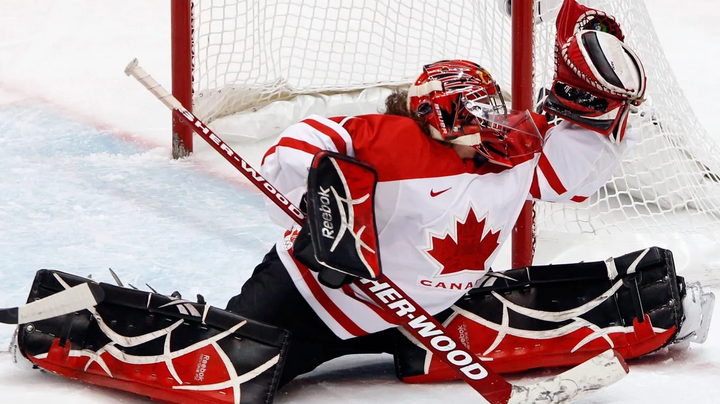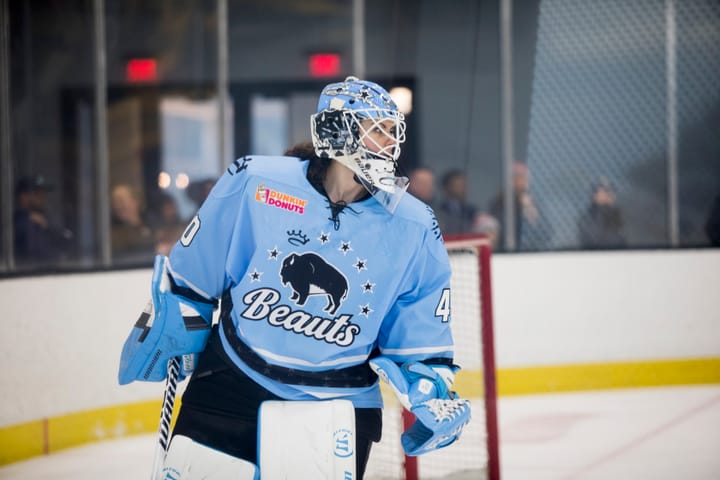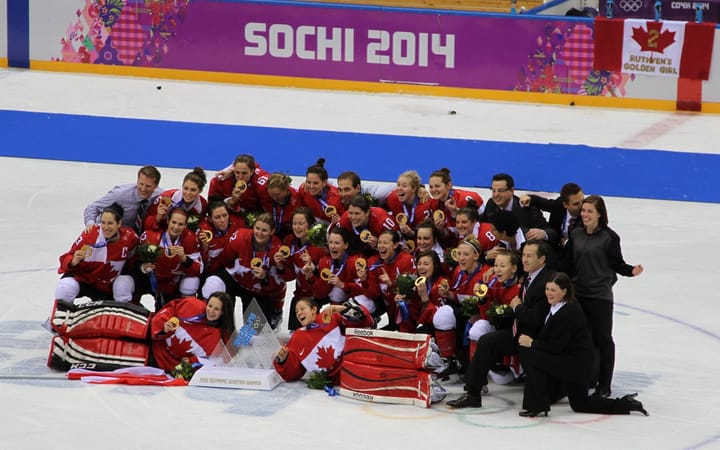The Takeaway: A slight reprieve from uncertainty
The WCHA welcomes St. Thomas; Ivy League schools face a postponed start date
It’s been an offseason filled with unknowns and uncertainty. There’s still so much that remains to be decided about how (or if) the 2020-21 women’s college hockey season will be played, and how many teams will participate if so. But within the past couple of weeks we’ve finally gotten some definitive answers from certain schools, as well as official news about a new Division I team. Some updates and thoughts ahead in this mid-July edition of The Takeaway.
5 Things to Know
St. Thomas joins the WCHA: In a joint presser last week, the University of St. Thomas announced that it will be transitioning from Division III to Division I competition, and as part of that transition, the Tommies’ women’s hockey team will join the Western Collegiate Hockey Association in 2021-22.
The WCHA was an eight-team league up until 2017, when the University of North Dakota cut its women’s hockey program. That left a sizable hole in the conference schedule for the remaining teams, since WCHA squads play each other four times a year. It tends to be difficult to fill in the schedule with non-conference opponents as well, since there aren’t many other schools within driving distance of WCHA teams.
For those reasons, adding an eighth school to the mix has been priority number one for Jennifer Flowers since she took up the reins as WCHA Women’s League Commissioner last summer.
“We didn’t want an eighth team just to have an eighth team. We wanted an institution and a program that brought value to the league, and that helped us solidify our place as the best women’s college hockey conference,” Flowers said. “We feel incredibly confident that St. Thomas brings all of that to the table for us.
“They have a storied Division III program, so yes, it will take them some time likely to elevate their play, but anything that St. Thomas has done historically, they’ve done phenomenally well and I don’t doubt that this will be the same case.”
Flowers said that the WCHA has been in talks with St. Thomas for about a year in regards to the team joining the league. Initial conversations centered around feasibility. St. Thomas then went through a full application process, which included presenting virtually to the entire WCHA membership.
In April, the WCHA Board of Directors voted to extend an official invitation to St. Thomas to join the league. On their side, the Tommies were waiting to hear back from the NCAA on their request for a waiver to jump directly from Division I. With that now granted, they’ll officially join the WCHA.
St. Thomas is actually the first institution to transition directly from DIII athletics to DI, so there’s some history being made here. The Tommies’ transition period will last five years; during that time, they won’t be eligible for NCAA postseason play, but they will be immediately eligible for WCHA regular season and postseason championships. Flowers said the transition process is similar to what would take place for a school going from DII to DI.
“There are definitely some parameters, which is helpful for all of us as the transition happens because it allows them to transition slowly and effectively,” she said. “And so they will phase in their scholarship plan, they will phase everything in over this five-year period, which is amenable to our league, no doubt about it.”
Regionally, St. Thomas is a definite fit for the league; based in St. Paul, they’ll become the sixth team to call Minnesota home. But as a private institution in the Twin Cities, Flowers noted the Tommies bring a few unique characteristics to the table as well.
“They’re athletically and academically an outstanding institution. They’ll be our first private school, which I think diversifies our league a bit,” she said. “They already have a fanbase. They already play in the state of hockey, which I think for young girls and high-school-aged girls playing hockey in Minnesota, this is another amazing opportunity to have a Division I option right here. They bring with them a metro media market that is a bit different than what Minnesota has, so I think they really balance each other nicely.”
Consistent with campus health & safety policies across the League, The Ivy League Presidents outline phased-in approach to intercollegiate athletics activity, including no competition prior to the end of the fall semester due to the COVID-19 pandemic.
— The Ivy League (@IvyLeague) July 8, 2020
📰» https://t.co/7iwQGnECsT pic.twitter.com/DYUFoFshA4
Ivy League delays season until at least Jan. 1: This one is old news by now, but so far, the Ivy League’s announcement is the only one to directly affect Division I women’s hockey teams. The six Ivy League teams (Brown, Cornell, Dartmouth, Harvard, Princeton, and Yale) will not start winter sports competition until Jan. 1 at the earliest.
It seems unlikely that those six schools will be the only ones affected by pandemic-related season delays, but they’re the first to officially be dealing with a shortened (or potentially canceled) season. The Ice Garden spoke to Princeton head coach Cara Morey and Harvard head coach Katey Stone about preparations for the upcoming season, knowing that things are going to look much, much different no matter what happens after Jan. 1.
Plenty of decisions ahead for incoming and returning players: At the time we spoke, both coaches said their respective classes of incoming first-years were still finalizing their decisions on whether or not to defer admission for the 2020-21 academic year.
Morey noted that she has some open spots in the fall of 2021 incoming class, so that could help negate any major effects on long-term outlook for recruiting. But for virtually every school, that’s going to depend largely on how many incoming players decide to take a gap year.
“If the entire class were to defer, it’s obviously really going to affect the incoming class of 2021 and their numbers. If it’s a handful here and there, then it may not,” Morey said. “I think that every single school is going to have to figure out, with their potential gap-year players, potential redshirt players, how to manage the recruiting classes for the next couple of years to try to balance this out.”
There’s some insight into the decision-making process from the players’ point of view in this article about incoming Princeton player Mia Coene and incoming Brown player Rose Jeneault.
Incoming players aren’t the only ones who will need to decide what to do this year. Returning student-athletes also have the option of taking a semester or a year off. Inevitably, as more schools push back fall and winter sports, players around the country will be faced with that decision. Do they return for a year clouded by uncertainty to play what would be a shortened season, if there is one at all? Or do they take time away from school completely?
It isn’t solely about hockey, either. Players will need to weigh a multitude of factors, and what’s best for one student-athlete may not be what’s best for someone else. Certain players, for example, may have hopes of making an Olympic roster in 2022, and need to ensure they can continue training for that. Others may have post-grad plans lined up that they don’t want to push off.
“I think there are a lot of factors,” Stone said. “Whether the whole remote learning situation is a positive one for them or not, I think that’s huge. Whether their training situation at home is good or not. There’s so many factors and our kids have been listening to everything that Harvard’s offering as far as webinars and information sessions.”
“We have to do what’s best for each of our players,” Morey said. “We’re working with each player individually on their academic goals, their hockey and athletic goals, and then what their plans are for post-college. Everybody’s going to look at the situation a little bit differently.”
"There is not a doubt in my mind that the person I left Harvard as two months ago is better than the person who entered."
— Harvard Athletics (@harvardcrimson) June 22, 2020
Read what Ali Peper from @HarvardWHockey had to say about her time in Cambridge! #GoCrimson | #Harvard20
📰:https://t.co/MJHxYGugY7 pic.twitter.com/oj4mEGalPO
Coaching in the age of COVID: Both Harvard and Princeton are limiting on-campus instruction this fall to specific groups of students to hopefully lower transmission of the coronavirus. At Princeton, first-years and juniors will be on campus in the fall, and sophomores and seniors will be on campus in the spring. For Harvard, campus will be open to first-years and other students who need to return in the fall.
That means that even if hockey is played after Jan. 1, the fall semester is going to look very different from a training and coaching perspective. Teams are likely to see a much smaller group of players physically on campus and skating together, if it’s safe to do so. In the best of times, establishing a positive team culture and creating a cohesive dynamic is no light undertaking—and that’s with every player in the locker room together on a daily basis. But now, teams will be separated until at least the end of the calendar year, if not longer.
That can be tough to manage, but Stone says there will be a heavy focus on communication to keep players on track and ready to compete, even if they can’t physically be there together.
“When the dust settles and we figure out where everyone is in the fall, whether they’re on campus, whether they’re learning remotely, or whether they’re deferring, we’re going to be in touch with our players,” Stone said. “We’re going to make sure that they’re as prepared as could be in the event that we get to play in January, which I’m going to remain hopeful. And then, if it doesn’t happen, we’re going to chart our course for the next season.”
Things will certainly be different in terms of on-ice practices, but it leaves some room for creativity and for players to take some ownership over their individual development.
“Mel [Ruzzi] and Courtney [Kessel] and I are going to be skills coaches for quite a while, which is good because that’s a passion of ours; we love the development side of coaching anyway,” Morey said. “But then it’s going to be a lot of small group work. We’re not going to be running flow drills until potentially January.
“I think it’s going to be sitting down with the players and making a plan together and kind of having them help script it so that the buy-in is there. Because it would be really hard for me as an athlete to show up for just individual sessions repeatedly without knowing if there’s going to be a season to perform in.”
BREAKING | Former @RITWHKY standout Celeste Brown '15 named Bruce B. Bates Women's Hockey Coach - https://t.co/sRJ4TVvYGc pic.twitter.com/EuYTmfC2t5
— RIT Athletics (@RITathletics) July 17, 2020
Celeste Brown named head coach at RIT: Former Tiger player Celeste Brown has been named the new head coach at RIT. She last played for RIT in 2014-15, when she captained the squad as a senior. She’s spent the past three years behind the bench at Penn State as an assistant. There’s a nice feature here from the Great Falls Tribune about Brown, who’s a Great Falls native.
Brown is the third head coach for the Tigers in their Division I history and she’ll replace Chad Davis at the helm. Davis coached the team for the past two seasons. RIT had a record of 12-19-4 in 2019-20 and they’re looking for their first .500 season since 2013-14.





Comments ()